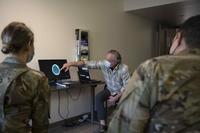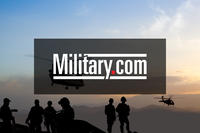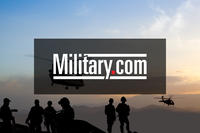 Military Update: Caution Flag Up on More Easing of VA 'Choice Card' Usage
Military Update: Caution Flag Up on More Easing of VA 'Choice Card' Usage
An actuarial firm under contract to the Department of Veterans Affairs projects that allowing veterans who live more than 40 miles from needed VA health care to use private sector care instead could balloon VA health care costs by as much as $46 billion a year.
That blast to the VA budget is a worst-case scenario, the upper range of possible cost growth, presuming almost four million veterans eligible for VA care, and residing more than 40 miles from a VA medical center, decide to drop employer-paid insurance, TRICARE, Medicaid or Medicare and rely solely on VA-purchased care from nearby private physicians and hospitals.
Some veterans’ groups and VA officials fear Congress is on a course that could make the prized VA health system unaffordable by exploding reliance on private sector care through the new Choice Card program and further easing its restrictive 40-mile rule.
The independent actuarial estimate echoes a $51 billion VA cost projection the Congressional Budget Office gave to Congress last July as House-Senate negotiators finalized the Choice Card program enacted as part of the Veterans Choice, Access and Accountability Act of 2014.
Key lawmakers now dismiss the accuracy of the CBO estimate given data from the first several months of Choice showing VA made only 45,000 outside appointments for cardholders, and given a VA request for authority to reprogram some of the $10 billion earmarked for Choice through 2017.
The new law says cardholders must be able to access VA health care within 30 days or VA must arrange private sector care if requested. It also made distance from VA care a qualifying factor. But given the worrisome CBO cost projection last year, lawmakers shaped the law’s 40-mile rule awkwardly to keep Choice eligibility intentionally tight.
It did so in two ways. House-Senate negotiators added language to their report on the bill telling the VA to use straight-line distance, not driving distance, to determine whether vets reside beyond 40 miles of the nearest VA health facility and thus qualify for outside care.
Also the law itself was written so vets aren’t eligible for VA-paid private sector care if they reside within 40 miles of any VA health facility, including more than 800 clinics, even if needed VA specialty or hospital care is a lot farther away.
CBO had advised that without such restrictions the $10 billion earmarked for a three-year test of Choice swiftly would be exhausted.
But the nonsensical 40-rule rule, and the realization that VA administrators still serve as gatekeepers on accessing private sector care even for cardholders, has left many veterans confused, frustrated and flooding congressional and VA offices with complaints. This sparked a series of recent congressional hearings to review and reform the card program.
House and Senate veterans’ affairs committees now agree that the 40-mile rule is too limiting and their chairmen have promised relief.
Step one came last week when VA said it is revising the 40-mile rule regulation, replacing as-the-crow-flies distance with driving miles to the nearest VA hospital or clinic. The change requires cost analysis and a Federal Register process so it isn’t likely to take effect before late May. It also won’t be applied retroactively to any past denials of care.
Deputy VA Secretary Sloan Gibson blamed himself, but also didn’t spare Congress, when he acknowledged to the Senate Veterans Affairs Committee last week that use of straight-line distance was a bad idea.
“If you’re looking for somebody to hold accountable for the decision on driving distance I’m the guy…I tried my best to honor the intent of Congress,” Gibson said, referring to conference report language. He should have ignored that guidance and “done what we thought was the right thing for veterans,” he said, despite the criticism that surely would have followed.
This change, he said, will double the number of vets able to access private care using Choice, and also double program costs.
Sen. Johnny Isakson (R-Ga.), chairman of the Senate committee, applauded the move but said he wants to go farther, as does House committee chairman Rep. Jeff Miller (R-Fla.). VA-paid private sector care, Isakson said, should be available to any veteran who has to travel more than 40 miles to get the VA care they need. Choice should not be denied those who reside within 40 miles of a VA clinic that doesn’t provide needed care.
That change requires legislation, Gibson said, to modify the law. He also warned VA health costs would soar, and suggested VA work with committee staff to find a better compromise, perhaps an expansion of access to private care based both on distance and the kind of care needed.
Isakson didn’t oppose that but also said the VA shouldn’t worry what a second change to 40-mile rule would cost the department. If it “burns the money we appropriated out sooner,” Isakson said, “that’s a good problem to have because we are getting our veterans the care they deserve.”
But ignoring “burn rate,” Gibson said, “leads you very quickly” to making VA-paid private sector care available “40 miles from everywhere.” If that “aperture” to care becomes too wide, he warned, the cost to VA would be “multiples of the $10 billion” now budgeted for Choice.
VA had the actuarial firm Milliman estimate the jump in costs. The result almost matched what CBO projected last year. Roughly 3.9 million veterans eligible for VA care reside more than 40 miles from a VA medical center, and 81 percent have other health insurance. If they become eligible for Choice, and if Congress signals the program will be permanent, these vets could drop current insurance for less costly VA-paid community care.
The fear then becomes “second order” effects. If VA facilities lose enough patients they appear inefficient. Funding cuts then could impact medical education, research and emergency preparedness for future wars.
Some veteran groups share those concerns. Others do not.
Disabled American Veterans worries Congress won’t adequately fund both a Choice program and the VA health system, said DAV legislative director Joseph Violante. When the first $10 billion for Choice is gone, he predicted, money could be diverted from VA’s direct care health system.
Whether Choice costs climb to $50 billion annually or not, Violante said, “Congress will have to find additional funding to be sure VA can be both a provider of care and an insurer.”
“I am not sure how they will pay for it,” said Carl Blake, an executive with Paralyzed Veterans of America. “While I understand the position that Chairman Isakson and others have raised about the availability of a service at a facility, the cost of expanding [Choice as eyed] would be massive.”
But Louis Celli, director of veterans’ affairs and rehabilitation for The American Legion, is skeptical of both VA and CBO cost projections, given the modest number of appointments made through Choice so far.
“Even if it did turn out to be 10 times greater, the base number VA reports” as using Choice “is so small that a ten-fold increase still wouldn't meet or exceed original estimates.”
He lauded the new program as an experiment to help VA identify gaps in providing care. After three years, program data can be used to shore up existing contract authority for VA purchase of private sector care as needed.
“If VA uses the program as intended, to be a safety valve to provide care not otherwise available through VA, then this will be a successful program,” Celli said. “But if VA uses Choice to replace any of their existing authorities or funding accounts, then this program will fail to yield the lessons critically needed to move VA forward as the premiere solution to provide veterans the healthcare they have earned and deserve.”
Read more news about the VA Choice Card program.
To comment, write Military Update, P.O. Box 231111, Centreville, VA, 20120 or send email to milupdate@aol.com
# # # #
Tom Philpott has been breaking news for and about military people since 1977. After service in the Coast Guard, and 17 years as a reporter and senior editor with Army Times Publishing Company, Tom launched "Military Update," his syndicated weekly news column, in 1994. "Military Update" features timely news and analysis on issues affecting active duty members, reservists, retirees and their families.
Visit Tom Philpott's Military Update Archive to view his past articles.
Tom also edits a reader reaction column, "Military Forum." The online "home" for both features is Military.com.
 Tom's freelance articles have appeared in numerous magazines including The New Yorker, Reader's Digest and Washingtonian.
Tom's freelance articles have appeared in numerous magazines including The New Yorker, Reader's Digest and Washingtonian.
His critically-acclaimed book, Glory Denied, on the extraordinary ordeal and heroism of Col. Floyd "Jim" Thompson, the longest-held prisoner of war in American history, is available in hardcover and paperback.



